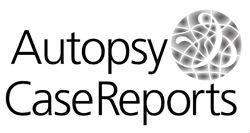Hypoxic hepatitis as a complication of newly diagnosed type 1 diabetes in a teenager
Kamil Buczkowski; Irena Ożóg-Zabolska; Jacek Gulczyński; Ewa Iżycka-Świeszewska
Abstract
Keywords
References
1 Ziegler R, Neu A. Diabetes in childhood and adolescence. Dtsch Arztebl Int. 2018;115(9):146-56.
2 Mobasseri M, Shirmohammadi M, Amiri T, Vahed N, Hosseini Fard H, Ghojazadeh M. Prevalence and incidence of type 1 diabetes in the world: a systematic review and meta-analysis. Health Promot Perspect. 2020;10(2):98-115.
3 Olivieri L, Chasm R. Diabetic ketoacidosis in the pediatric emergency department. Emerg Med Clin North Am. 2013;31(3):755-73.
4 Fayfman M, Pasquel FJ, Umpierrez GE. Management of Hyperglycemic Crises: Diabetic Ketoacidosis and Hyperglycemic Hyperosmolar State. Med Clin North Am. 2017;101(3):587-606.
5 Shahid W, Khan F, Makda A, Kumar V, Memon S, Rizwan A. Diabetic ketoacidosis: clinical characteristics and precipitating factors. Cureus. 2020;12(10):e10792.
6 Wolfsdorf JI, Glaser N, Agus M, et al. ISPAD Clinical Practice Consensus Guidelines 2018: diabetic ketoacidosis and the hyperglycemic hyperosmolar state. Pediatr Diabetes. 2018;19(Suppl 27):155-77.
7 Szmygel Ł, Kosiak W, Zorena K, Myśliwiec M. Optic nerve and cerebral edema in the course of diabetic ketoacidosis. Curr Neuropharmacol. 2016;14(8):784-91.
8 Trilok G, Qing YC, Li-Jun X. Hypoxic hepatitis: a challenging diagnosis. Hepatol Int. 2012;6(4):663-9.
9 Fuhrmann V, Kneidinger N, Herkner H, et al. Hypoxic hepatitis: underlying conditions and risk factors for mortality in critically ill patients. Intensive Care Med. 2009;35(8):1397-405.
10 Aboelsoud MM, Javaid AI, Al-Qadi MO, Lewis JH. Hypoxic hepatitis - its biochemical profile, causes and risk factors of mortality in critically-ill patients: a cohort study of 565 patients. J Crit Care. 2017;41:9-15.
11 Birrer R, Takuda Y, Takara T. Hypoxic hepatopathy: pathophysiology and prognosis. Intern Med. 2007;46(14):1063-70.
12 Raurich JM, Llompart-Pou JA, Ferreruela M, et al. Hypoxic hepatitis in critically ill patients: incidence, etiology and risk factors for mortality. J Anesth. 2011;25(1):50-6.
13 Henrion J. Hypoxic hepatitis. Liver Int. 2012;32(7):1039-52.
14 Waseem N, Chen PH. Hypoxic hepatitis: a review and clinical update. J Clin Transl Hepatol. 2016;4(3):263-8.
15 Lightsey JM, Rockey DC. Current concepts in ischemic hepatitis. Curr Opin Gastroenterol. 2017;33(3):158-63.
16 Zubkiewicz-Kucharska A, Gorlo A, Noczyńska A. Acute hypoxic hepatitis as a complication of diabetic ketoacidosis in a boy with newly diagnosed diabetes. Pediatr Endocrinol Diabetes Metab. 2020;26(2):108-12.
17 Patita M, Nunes G, Alves de Matos A, Coelho H, Fonseca C, Fonseca J. Mauriac syndrome: a rare hepatic glycogenosis in poorly controlled Type 1 diabetes. GE Port J Gastroenterol. 2019;26(5):370-4.
18 Alhajjaj AH, Aljishi FK. Mauriac Syndrome Still Exists in Poorly Controlled Type 1 Diabetes: a report of two cases and literature review. Cureus. 2021;13(4):e14704.
19 Garland JS, Werlin SL, Rice TB. Ischemic hepatitis in children: diagnosis and clinical course. Crit Care Med. 1988;16(12):1209-12.
20 Martin J, Tomlinson P. Hepatic complications in poorly controlled type 1 diabetes mellitus: a case report. N Z Med J. 2014;127(1392):95-7. PMid:24806252.
21 Szypowska A, Skórka A, Pańkowska E. Acute hypoxic hepatopathy: diabetic ketoacidosis complication in an infant newly diagnosed with type 1 diabetes mellitus. Pediatr Endocrinol Diabetes Metab. 2008;14(4):249-51. PMid:19239794.
Submitted date:
01/24/2022
Accepted date:
03/23/2022
Publication date:
04/14/2022

